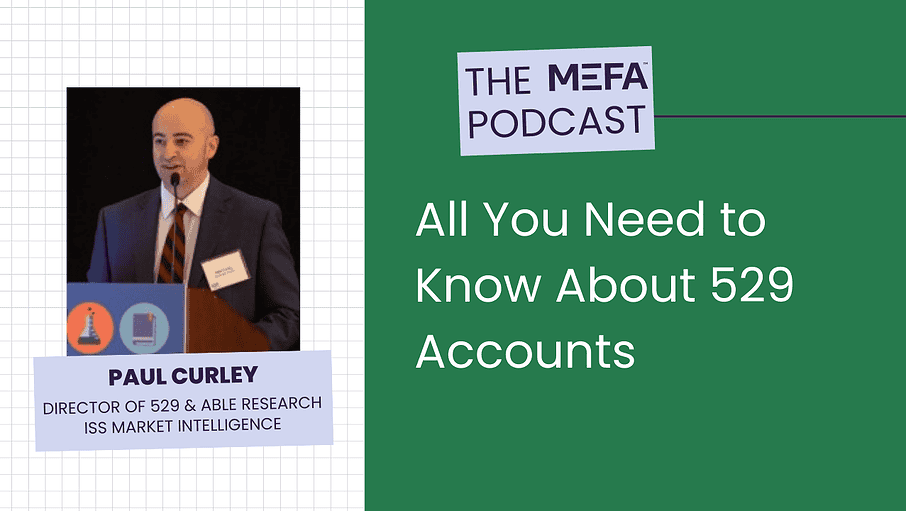Resources Mentioned in this Episode
Jonathan Hughes: Hi everybody. Welcome to the MEFA podcast. My name is Jonathan Hughes. Now we’ve had a run of great guests on the show lately, and that continues today because we’re so excited to have Paul Curley on the show with us. He’s the director of savings at ISS Market Research, but really, I just think of him and know him as one of the preeminent figures in the 529 world.
In fact, anyone I think was even a little bit involved in the field of 529s and college savings will know Paul Curley. He organizes the annual 529 conference every year, which brings the entire industry together to discuss developments and strategies. And he’s going to talk to us about some of the best strategies to save for college among other topics 529 related.
And why is he going to do that? Because it’s the end of May. And that means that 529 Day is coming up. So this show is going to be all about college savings and specifically 529s. And to that end, MEFA has a whole spate of activities this week for 529 Day. Do you want to go through some of those activities, Julie?
Julie Shields-Rutyna: Oh, sure. I’d love to. And I always, I just like to share how, yeah, we, like, we just like that little play on the month and day 529 to talk about one of our favorite numbers, 529. And we’re always trying to get people to save and understand 529 plans. So to that end, we have all these activities happening.
And, we kick things off with a webinar on Attainable®, which is the Massachusetts ABLE program, which is actually a 529a plan. And that’s a savings program for individuals with disabilities. And so we like to include the Attainable® enabled programs as part of 529 week. So Mary, who is our Attainable® Program Manager, will have a webinar that’s going to be terrific on May 24th at noon.
And we’ll post links to all of this, I assume. And then, later on May 24th at 6:30 PM, there’ll be MEFA’s college savings webinar hosted by Jonathan. So lots going on on the kickoff day. Then, actually, the next day is kind of what we’re calling the centerpiece.
And it’s a revisit of an event from last year where the State Treasurer, Deborah Goldberg, and our own Executive Director, Tom Graf will come together on a webinar to talk about the BabySteps Program, which is the statewide seeded college savings program that invests $50 for every child born or adopted in Massachusetts, as long as they open a U.Fund, which is, you know, Massachusetts’s 529 plan.
So that’s going to be terrific. And then the next night. We have our friend and colleague Carmen Pineda who will be hosting a Spanish language saving for college seminar, a webinar at 6:30 PM. And we close out the week with a Twitter chat on savings and 529 plans.
Jonathan Hughes: Thanks for listing all those events. And, you know, since this is happening this week of the week of 529 or the week actually before 529, since the actual date of May 29th is Memorial day.
If you’re hearing this podcast before. For these events, you can go on the links and check it out and RSVP and attend those webinars. If you want to do that, if you’re hearing it later, we record all of these webinars. So you can go ahead and access the recordings to those webinars that we mentioned and do it at your convenience.
But, thank you so much, Julie, for running through those events. Now it’s time to go and open up the MEFA mail bag. And these are questions that have come into us from customers over the past two weeks and answered by our college guidance experts. Remember, if you have any questions, you can please reach out to us at [email protected], or you can call us at 1-800-449-MEFA.
We’re also available on social media. You can find us on Facebook and you can view our Twitter @MEFAtweets. So we figured we would pick a college savings question to keep everything consistent. And this question comes to us from John who writes, I would like to know if it’s possible to open a U.Plan and a U.Fund account for the same person.
We’re considering opening one of each type, but I’m not sure if that’s possible. So I’m going to give away the answer a little bit. And ask Julie, who does have both a U.Plan and U.Fund account to talk about why you may want to do that.
Julie Shields-Rutyna: Sure. And I will share that I have both, U.Fund accounts and a U.Plan account out.
And I have two children, one graduated from college and one is still in college and I have been very happy to have both. And we get this question so often. And I like to just really stress that it’s not an either or, that both of these savings plans have benefits and can be used together.
So, quickly I’ll share that the U.Plan, which is the prepaid tuition program that’s connected with about 70 colleges here in Massachusetts, both public and private, that allows you to lock in a percentage of tuition over the years, and really can be super helpful benefit and savings, especially if your student goes to one of those 70 institutions.
But you know, my students didn’t. I laugh, one went to college in New Hampshire, the other is in Pennsylvania. But I, how do you plan to U.Plan account? And I, I have still found it super helpful because at the time of my students going to college, I have been able to take cash out my U.Plan with no penalties.
And while I didn’t get that extra benefit of the tuition percentage lock-in in one of the participating colleges. I still had savings that was designated for college that, you know, I did get some interest on CPI interest and it was really right. They’re ready to help me pay those college bills. So that worked out for me and for students, families who have a student go to one of the participating colleges that really can work out even more, better.
Now that’s for tuition and fees. And so then even families who choose that plan, we also encourage them, to possibly open a, U.Fund, the 529 plan because U.Fund is for tuition, fees, room and board, books, supplies, really all required expenses and can be used at any accredited institution in the United States.
And even some international colleges. So it’s very flexible and can be used for that wide range of expenses. And so I have also really liked having the U.Fund to help me pay for my kids education.
Jonathan Hughes: Thanks, Julie. Yeah. I’m glad you mentioned that, you know, we always talk about these plans or like to talk about these plans, as complimentary.
So it’s great to talk to you. Somebody who has used the plans that way, and we know that any way that you can save is a good way to save. If it can save a one of these ways, it’s even better, if you can save in both of them even better still. So thank you so much for that. Now we’re going to close up the mail bag.
And once again, I’ll say if you have any questions, you can reach out to us at [email protected], or you can call us at 1-800-449-MEFA. So we’ll go now to my conversation with 529 expert Paul Curley. You’re going to enjoy this.
Currently as the Director of Savings Research at ISS Market Intelligence, and one of the more preeminent figures in the 529 world, as I’ve said earlier in the show, he is the organizer of the national 529 conference, which brings together experts and 529 providers from all over the country together, which will be taking place this November.
And we’re just thrilled to have him here on the podcast for our 529 Day edition. Paul, thank you very much for being here.
Paul Curley: Thank you for the opportunity and happy to help out in any way.
Jonathan Hughes: How would you put that with my own kind of version of what you do? How would you put it? What you do, right?
Paul Curley: So those two are two different takes. The first is right. So I’m the director of 529 and ABLE research, with ISS intelligence. I oversee data research, events, digital, and that data bucket, you know, the how is that? Since 2001 we’ve been aggregating the data talking about trends.
And we do an annual survey of parents, annual survey of advisors. We do product training and networking in our conference. And then we also have the media on that got milk campaign of just getting that message out there. But the more intriguing question, John, that would actually be the why. And for me, I’ve really loved numbers.
So financial service industry was my thing. I wanted to help families and education is very important to me. So hence 529s and ABLE as well. And we’re happy to cover it.
Jonathan Hughes: Moving right to it. If you had to convince young parents that it’s worth it to save for college, what would you say to them and why would you say a 529 in particular would be useful for them?
Paul Curley: Right. You know, so from the perspective of it just being a part of save and save efficiently, and in those small incremental sort of like stepping stones to that, the ultimate goal of saving for college, there’s the argument that same for CA like having a dedicated fund or, you know, say college fund will actually increase the likelihood of, of one going to college.
But of course there’s also all the different perspectives of, you know, why college, you know, that being that, you know, in general, in our data, in our research as is publicly available, you know, like more education leads to more income, lower unemployment. And as we saw intriguing, third element is actually in 2020, 2021, the trending conversation being around also the type of work one does. Right? So for me, I was able to telecommute and just be safer. So there’s that safety on that quality element of more education leading to, you know, higher income overall lower unemployment, and also quality of sort of what work life balance.
Of course now it’s great to see my own beneficiaries as well. And why 529 plans, you know, broadly speaking, there’s that benefit from the tax financial aid and estate planning kind of benefits that that 529 does have. Of course also that just add an element of just having a dedicated account and just being able to put in that, for that long-term goal of saving and paying for education, just that automatic contribution, putting that $50 a month, you know, which helped out a lot of families, you know, last year with the market volatility going up and down.
You know, for me, it’s an 18 year goal. I slept 10 more years. So with the market down, it really didn’t impact me because I was just putting in my X number a month. And you know, it works for families.
Jonathan Hughes: You said you do market research and researching trends. What are you seeing right now in terms of 529 investments?
Paul Curley: Well, you know, and we take a much bigger picture as well. I mean, that savings rate of roughly 26 to 28% is just mind blowing. Cause even in the sixties, seventies, and eighties, that higher threshold of an 18% savings rate was, was at the, at the cap. Of course, that that savings rate had kind of trended down and all of a sudden the big picture of more people saving overall.
And then from that perspective, there’s more people, you know, saving overall. There’s more people saving for college and education. And then of course also using, you know, saving with a 529 plan as well. Just sort of like that element of now that the, all the different emergency funds are, are back-filled and of course all the different stimulus payments as well.
They kind of help people to have more revenue at the same exact time when it’s just been, you know, in lockdown, it’s just harder to go out and spend and travel and go out to restaurants, which I love to do. But that being said it’s, or as we all love to do is just, you know, more people are saving things, more people are using with it.
Jonathan Hughes: I’ve had, as you, I imagine, have had conversations with new parents, any parents really in your day-to-day life, about 529 plans, especially when you’re talking about what you do for a living and they might want to talk to you about what’s the best way to save or which 529 plans should they invest in. Of course, we’re not going to tell people what 529 plan they should invest in. But what should factor into their decisions when they’re looking at that?
Paul Curley: Yeah. And it’s very timely because we’re cutting the data right now on our survey of parents. And, you know, this survey says, and of course I’ll also make sense is that first people look at, you know, what’s the best performing 529s.
And then from that perspective, what’s the lowest cost. You know, 529 plan from that perspective, but looking at the state tax incentives that you may or may not have it in your state as Massachusetts does have for the mutual plans. But also the fourth one is, you know, the user-friendly element, which is very intriguing.
And of course I, or as I put it in my own common speak, the best one is the one you use. Right? So just making things super simple and just easy to use all the better. And frankly, from my own independent third-party perspective, I think that for, you know, for U.Fund and, and obviously working through Fidelity, just that 2% credit card is a great way.
It is have a very easy lift. And so you open the account, have that 2% credit card there, you start seeing it and funded the child’s growing and you’re like, wow, they’re getting older. And, you know, getting the gifting platforms as your team does have all the different sort of elements just makes it easier and easier for people to save.
Jonathan Hughes: Now, one thing that I really found interesting when I was attending at the 529 conference is that they give a great overview of 529 plans. And we’re kind of starting at the beginning here in the middle, which is odd, but if you could just walk people through the origination of 529 plans and where they started and where they’re going.
Paul Curley: When 529s we’re first sort of, you know, brought out they were focused more on, you know, tuition, inflation, and ways that families can kind of combat that. That college kind of focus that undergrad focus there was that, you know, expansion of focus to those mid-career accelerators, retooling the skill sets are, or those looking for career changes.
So not just college, but grad school and what we saw over time, as it was for legislation that expansion of not just being for college, but K through 12 private school tuition, to apprenticeships, you know, the student loan side. So we’ve really seen an expansion of 529s for college, 529s as being an educational goal, whether one is saving or even repaying side of the conversation as well.
Jonathan Hughes: And one of the most important expenses you mentioned right up at the top, which was the 529a program or the ABLE program. And I was wondering if you could talk about that.
Paul Curley: Yeah. You know, for the set up as well, very similar tax structure that the 529 plans, and it was the same sort of tax structure for 529 is actually the tax code. And so they, the same tax code used for 15 has as for 529 for ABLE accounts. And they really are, you know, at will accountants.
They are in an investment vehicle that helps certain families with disabilities save for qualified expenses and the treating thing all meant, you know, for them is that there’s a quicker usage cycle, right? So there’s the ability to, you know, put money in, get the state tax deduction in certain instances, have the assets grow and then use the money for qualified expenses at a much quicker cycle than say for college. Right?
So for college, there’s, you know, sometimes the 18 year window, or if you just graduated from college and, you know, perhaps, you know, saving for that MBA for in that five years down the road. Or even if it’s newborn using for K through 12, that’s still a five-year window where for ABLE, it’s a much shorter cycle for putting the money in and using it for the expenses.
And so they continue to grow and do quite well.
Jonathan Hughes: What are some of the more effective strategies that parents or families have used to save for college
Paul Curley: Yeah, I mean, and it’s just so important to just start early. You start when the child is born, and granted for me, it took myself six months to open up my own account and it’s, you know, it takes five minutes.
So it was, you know, very quick and easy from that perspective. But, you know, just putting in that, say like 1% of your income, you know, just as one would with a 401k. So it’s just that. So like the automatic contributions and helps you to really ride out those different kinds of waves in the market.
So I think that’s sort of, you know, I would actually think that that’s the best strategy of just, you know, the child’s born, open the account and just putting in those automatic contributions. Now, once that is set up, or inversely perhaps, you know, having that credit card points kind of go in at 2% with Fidelity that can go into the mutual account.
I think that’s just one of those easy, you know, free layups, right? I mean, especially we saw last year, it was hard to use those hotel points or airline points. So, and, you know, rain or shine the 529 and, you know, points always work right down the road. So you know, that’s a great strategy.
There’s also the gifting and the birthdays and I know for myself, I get a lot of noise making toys from in-laws and things that twist my ankle. So I always returned those immediately and return it and put that money in the 529. And that’s just a great way to kind of have multiple different kind of incoming contributions in.
And of course the big theme and strategy that I’m trying to champion, I think is a great strategy. It’s just, you know, having that employer channel automatic contribution coming in, you don’t see the money. You’re not thinking about it. You’re not looking at the market is up or is that what’s going on today in the news.
And it just, you know, comes out of the account right into the 529 account. And it’s just one more way to sort of just build that sort of, you know, goal of that, you know, that college fund that can really kind of accomplish the goal. You know, I think what happens too often is that people see the price tag of whatever school it may be.
I know that I was shocked when my undergrad all end was, was no crack that the $30,000 per year number for tuition room and board. But now it’s more than double, you know, so to the extent that it’s, I just think a lot of it is just, you know, starting early, starting with the small amounts, and then once you have the account, you think like, oh, what can I do? It is sort of, you know, power up that, that account.
Jonathan Hughes: I relate because you said it took you six months to open up your 529. And when you actually started took five minutes, something similar in my case, but only I hadn’t actually enrolled nine months. You know, it took me nine months to realize that I was putting money away because my wife had set it up and set up an automatic withdrawal out of my checking account.
So to your other point, that’s a very effective way to do it. And I always talk about that. I was talking about the conversation I had with my wife, right. So we have to start putting money in my son’s 529. It’s just like we’ve been doing it for nine months. I hadn’t noticed because just out of sight, out of mind.
Paul Curley: Now I usually, and another great strategy is actually to set up the account before the baby’s born.
Cause you can change the beneficiary from yourself or your wife to the child’s that, you know, as I was about to say, when thinking, you know, and talking to you, it’s like, you know, perhaps when you start sleeping more than 5.29 hours a night, that’s when you should open up. the 15 month gap was like, wait, but you really don’t have to wait until that number.
You know, that stage at six months, probably you can actually set up before, you know, do the automatic contributions that easy lift as, as you were saying before, and then. You know, when you do start sleeping more than five hours a night, you know, you’re already there and you’re out of the shoot and a little bit.
Jonathan Hughes: So 529 plans are generally considered, I think the vehicle of choice when it comes to saving for college. And, you know, can you tell me what we know about how popular they’ve become over the years?
So how well have we done in promoting 529 basically? And what do we need to do better?
Paul Curley: Yeah. You know, and thinking about how there’s 15 there’s 15.1 million 500,000 accounts out there. It translates into roughly 12% of, of family households, you know, based on us census numbers. So, roughly 12% of households are saving with a 529 account.
And broadly speaking, you know, that they’re strong, they’re growing and obviously, and that’s, that’s all great. But when, when I kind of think about things and, when you, when we do a total market size of the amount of money you saved in529s or cash or 401ks as some families do. You know, save for college.
We kind of come out to a, roughly 1.5 trillion being saved for right now for college. You know, so we have the opportunity to get more people to, you know, basically move the money from cash or to 529s or all these other vehicles. The student loan debt numbers is now 1.7 trillion going to 1.8. So as successful as 529s have been to getting that message out there, there’s still a fairly large, significant opportunity to just get more people to, you know, save officially, start early with the baby steps. And I think we’ll get there.
Jonathan Hughes: We host the national 529 conference, as I’ve noted and that does bring together representatives from 529 plans from all over the country and from just the field of college savings.
So, you know, it, it’s a great opportunity for people to compare notes and to compare strategies. What are some of the most interesting or clever or effective promotion strategies that you’ve learned about from some of your colleagues?
Paul Curley: Yeah. You know, if I actually made a power goal for this one, so I was thinking about this.
I was like, this question’s probably coming up. And the first one is an ice cream truck, you know, so in certain states we’ll drive around an ice-cream truck and like hand out free ice cream, you know, with the sign on the side. That’s pretty cool. Right. That’s a great idea. Like a mascot. There’s a couple of states with mascots and it’s like, that’s pretty fun.
Um, science museum exhibits. So for those that go up to Maine, they can actually see a, like an exhibit up there in Maine. There’s like onesies and kids’ t-shirts, there’s actually baby balls. Every single person that every single child is born in the state of Alaska gets a water bottle.
So, you know, that’s sipping and saving. The NHL, major league soccer and, sponsorships, NASCAR races, you know, festivals that entire festival being launched, a 529 conference Frisbees and New York times square billboards. And so those are sort of. You know, of course. And then of course, I guess my 11th would be, you know, coloring books that are much more around financial literacy, but how, how are the different ways to sort of like engage families in the moment of involving not just the parents with the child, but the, but the grandparents, the aunts, the uncles, and all the backers, if you will, of that child.
And of course, yeah, I mean, there’s the, on the more digital side, there’s the financial literacy platforms. We see mobile apps. And as though it is intriguing across the nation where, you know, for those that don’t have internet throughout the whole state, as I was in New Hampshire lesson, I’d probably say half the state has, you know, high-speed internet.
So it’s like, how do you do the outreach for those that do have access? How do you reach out to those that don’t? So there’s a lot of different ways to get that message out there.
Jonathan Hughes: Well, Paul, thank you so much for being here. Is there anything else that you want to mention before we go ?
Paul Curley: Save, save efficiently, take the baby steps, take the jump.
My only regret is that I did not open faster than I did wait that at six months. And you know, at the end of the end of the day is, you can get there with making the baby steps there. It’s a family goal and just get started. And thank you so much for time and effort and Jonathan for you and MEFA and the whole, you know, for the whole industry, we’ll all get there together in terms of just getting that a message and awareness out there.
So thanks for the time today and thank you for the opportunity.
Jonathan Hughes: No, I thank you for being here. And as this said, we’re all very excited that someone as preeminent as yourself was here for 529 Day for us also, I want to thank you again. And I look forward to finally seeing you again one day in person.
Paul Curley: So sounds great. Thank you. Take care.
Jonathan Hughes: Okay, well, that’s our show, everyone. Thanks, Julie. Remember, if you liked the show, please subscribe to us on Spotify, Apple podcasts, or wherever you’re hearing this. And if you could do us an extra favor and give us a five-star rating, we would love that. Once again, Julie. Thanks. I hope you had a good time on the show. So until next time, thanks everyone.











